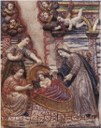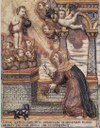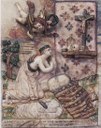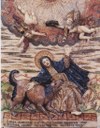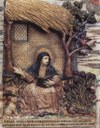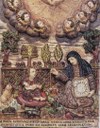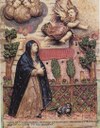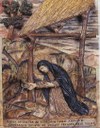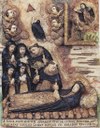Gallery 7:
The Life of Saint Rose of Lima (The Ocopa Series)

Title page, Series on the Life of Saint Rose of Lima. By Flemish
engraver Cornelis Galle II, c. 1675.
Huamanga stone is an opaque, ivory-colored stone that abounds in the area of Huamanga, Peru. Known also as Peruvian alabaster, it was carved since pre-Columbian times, as it is said to be so soft that it can be cut, when wet, with an ordinary knife. In Colonial times, it was used both for sculptures and for reliefs, often grouped in series like the one exhibited in this gallery (Banco de Crédito del Perú 1999, 313-324).
In 1671, Pope Clement X canonized Isabel Flores de Oliva as Saint Rose of Lima. A few years later, Flemish engraver Cornelis Galle II (1615-1678) produced fifteen engravings on the life of the saint. These engravings were subsequently used to illustrate a book on the life of Saint Rose. The volume, authored by the Jesuit cleric Juan del Valle, must have crossed the Atlantic, reaching an anonymous Huamanga stone carver, who produced a remarkable series of colored carvings in the second quarter of the 18th century (Soria 1948, 258).
Originally, the series consisted of fourteen carvings. Two of them were stolen, however, from their repository —the Convent of Santa Rosa de Ocopa, Junin, Peru—in 2008. Fortunately, all of the pieces were photographed before they were stolen. Copies of these photographs, together with those of their engraved sources, are now gathered in this gallery. The stolen pieces are 329B and 332B. PESSCA welcomes any information leading to the location of these pieces.
The series by Galle also inspired a later series of Huamanga stone carvings (Mujica Pinilla 2001, 50). Produced between 1820-1830, in the waning years of the Colonial period, this series of carvings is currently in Lima, in the Sanctuary of Saint Rose. See Lima 1998, cat. 17-45.


